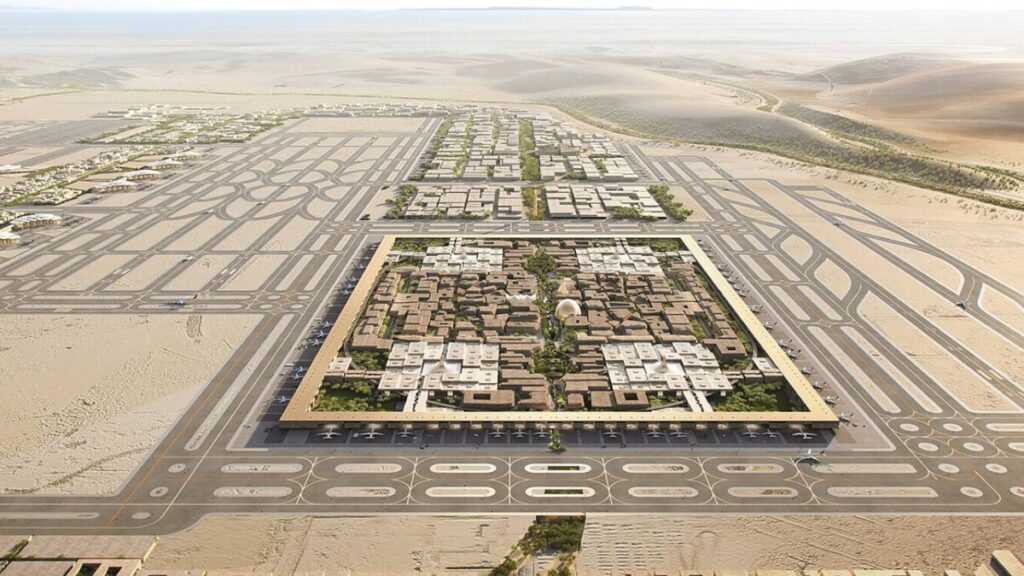In a significant move that could reshape global travel and commerce, Saudi Arabia is poised to reveal a project that may revolutionize the aviation industry. Following an impressive series of megaprojects such as The Line, Mukaab, and Epicon, the Kingdom has announced plans for what could be the world’s largest airport — a cutting-edge facility aimed at establishing Riyadh as a pivotal hub for international air travel by 2030.
A Transformative Project in Riyadh’s Heart
The anticipated King Salman International Airport is set to span an impressive 57 square kilometers in Riyadh, the capital of Saudi Arabia. This sprawling area will not only house the airport itself but also 12 square kilometers of residential and leisure zones. Plans include six parallel runways to accommodate the predicted surge in travelers, positioning it to outstrip the current largest airport, King Fahd International Airport, which is also located in Saudi Arabia.
This mega-hub is designed to handle up to 120 million passengers annually by 2030, with projections suggesting an increase to 185 million by 2050. The overarching vision is to create an infrastructure that promotes not only air travel but also the urban and economic development around it, effectively turning Riyadh into a true aerotropolis — a city where the airport and its associated facilities drive regional growth and prosperity.
Beyond a Traditional Airport: The Aerotropolis Concept
This initiative represents far more than a conventional airport with some runways and terminals; Saudi Arabia is aspiring for something much grander. By adopting the aerotropolis concept, Riyadh intends to weave the airport into a wider metropolitan framework where infrastructure, business, and residential areas revolve around the aviation hub. It’s a modern interpretation of how transportation influences urban development — akin to how railroads shaped cities in the 19th century and ports were instrumental in city expansion during the 18th century.
This innovative model enables the airport to serve as a catalyst for economic growth, significantly contributing to the local economy and acting as a critical node for global connectivity. The vision is clear: Saudi Arabia aims for Riyadh to rank among the top 10 global economic cities by 2030.
Sustainability and Innovation at the Forefront
The airport’s design will be led by acclaimed architect Norman Foster, ensuring a marriage of forward-thinking architecture and sustainability. The project seeks LEED Platinum certification, a prestigious recognition for energy-efficient building designs, establishing a benchmark for sustainable airport construction worldwide. With energy-saving technologies and pioneering infrastructure, the project is poised to serve as a blueprint for future developments in the aviation sector.
Seeing the Bigger Picture: A Vision Beyond the Terminal
However, the relevance of this project stretches beyond just air travel. The creation of an aerotropolis surrounding the King Salman International Airport aligns seamlessly with Saudi Arabia’s long-term strategy to diversify its economy away from oil dependency. By investing in such monumental infrastructure, the country is positioning Riyadh as a global entry point, appealing to both business and leisure travellers while accommodating its burgeoning population, projected to reach between 15 to 20 million by 2030.
Saudi Arabia’s proactive approach to air travel and infrastructure could well serve as a model for other cities worldwide that aim to blend urban development with transport hubs, establishing a precedent in the process.
The Emergence of a New Global Hub
As developments unfold, the world will be keenly observing Riyadh’s evolution into a vital center for global travel and commerce. With an emphasis on sustainability, connectivity, and innovative design, King Salman International Airport has the potential to exemplify the future of airports — transforming them from mere transit points into integrated urban environments that drive global economic growth.
As the countdown to 2030 begins, Saudi Arabia’s ambition for Riyadh to emerge as an international powerhouse becomes increasingly apparent. Will this megacity hub fulfill its lofty promises? Only time will tell, but one thing is clear: this project is destined to redefine our understanding of airports, cities, and global connectivity.







